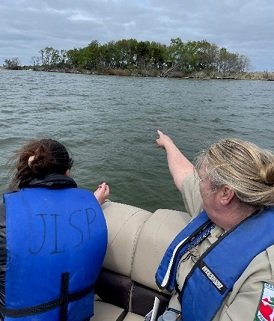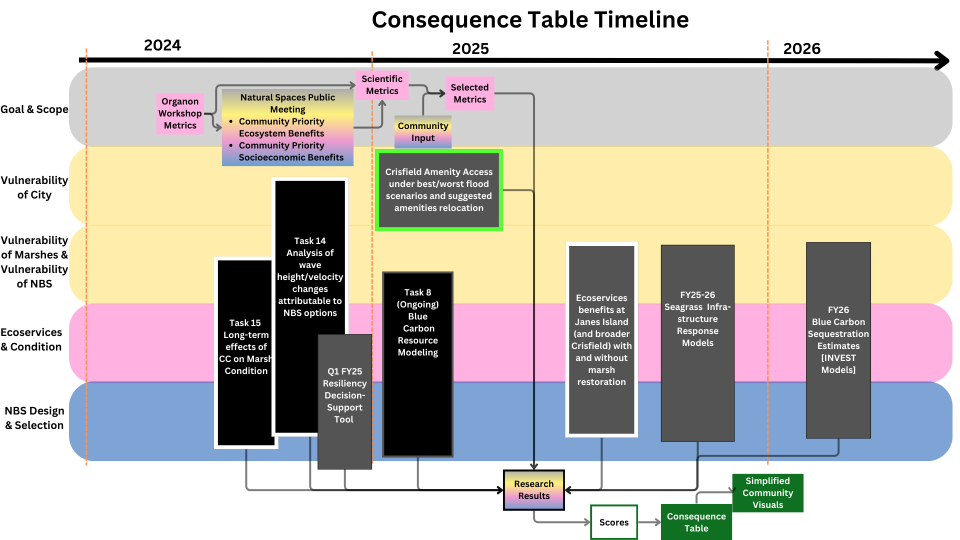Region 3 Chesapeake Bay Solutions-Driven Research Project

In this early pilot study, the Organon team has been working with colleagues engaged in a complex solutions-driven research (SDR) project. The goal is for the two parallel efforts to learn from each other as they both continue to develop in real time.
The SDR project falls under the Environmental Protection Agency's (EPA) coastal community resilience research, which includes a collaboration with multiple partners in the Chesapeake Bay region to investigate the ability of nature-based solutions (NBS) (e.g., salt marshes, dunes, living breakwaters) to reduce the impacts of climate change on coastal communities.
As part of a multi-disciplinary resilience-building project with the city of Crisfield, Maryland, the Organon framework and process are being used to help organize and integrate diverse research areas and synthesize results about potential NBS for community decision making. The goal is to increase community resilience to climate change by using NBS to mitigate the impacts of waves and storms while providing benefits to other ecosystem services that are also of value to the community, such as fishing and tourism (Figure 1).
To date, the Organon has been used to structure two internal workshops of EPA’s multi-disciplinary project team (over a dozen researchers) to:
- Identify how team members' various research components can contribute to combined assessment of NBS options for storm surge attenuation and other co-benefits
- Iteratively assess the status, progress, and linkages among research components and develop timelines (Figure 2) for completion and integration of results
- Discuss community engagement strategies for research co-production around goal-setting, regular feedback on methods and results, and decision support needs for evaluating NBS options to implement.
Workshop results will be used to inform the larger EPA-Crisfield community team in a co-production process for:
- Analyses of which NBS options have the greatest potential to serve the resilience needs of the community
- Visualizations of NBS trade-offs in terms of effectiveness for coastal resilience, equity of benefits, project feasibility, etc.
- Climate-smart considerations to inform NBS design for long term effectiveness and resilience
Full research results and decision outcomes of this partner project will be available in 2026.
Partner Team
City of Crisfield, Maryland*
Darlene Taylor, Mayor
Jen Merritt, Grants Administrator
*The Crisfield community is the key partner of the larger solutions-driven research project, which the Organon is supporting through internal EPA team workshops and planning.
EPA Chesapeake Bay Solutions-Driven Research Team
Leadership:
Roxolana Kashuba, Environmental Science Lead, Office of Research and Development (ORD), Integrated Climate Sciences Division (ICSD)
Emily Eisenhauer, Social Science Lead, ORD ICSD
Research, Communications, and Workshop Participants:
Susan Yee, ORD Center for Environmental Measurement and Modeling (CEMM)
Jordan West, ORD ICSD
Ian Reilly, ORISE Fellow at EPA
Justin Bousquin, ORD CEMM
Kyle Buck, ORD CEMM
Caroline Cole, ORD
Tanja Crk, Office of Water
Jessica Daniel, ORD
Alex Dhond, ORISE Fellow at EPA
Megan Fitzgerald, EPA Region 3
Rich Fulford, ORD CEMM
Jenna Hartley, ORD ICSD
Matt Konfirst, EPA Region 3
Anne Kuhn, ORD CEMM
Candace May, ORD ICSD
Steve Pacella, ORD Pacific Ecological Systems Division
Regina Poeske, EPA Region 3
Louie Rivers, ORD
Blake Schaeffer, ORD CEMM
Marie Schneider, Student Services Contractor at EPA
Elizabeth Stanziano, ORD
Abigail Sullivan, ORD ICSD
Veerani Tailor, Student Services Contractor at EPA
Emily Trentacoste, ORD
Technical Support
Anna Hamilton, Tetra Tech, Inc.
Jen Stamp, Tetra Tech, Inc.

